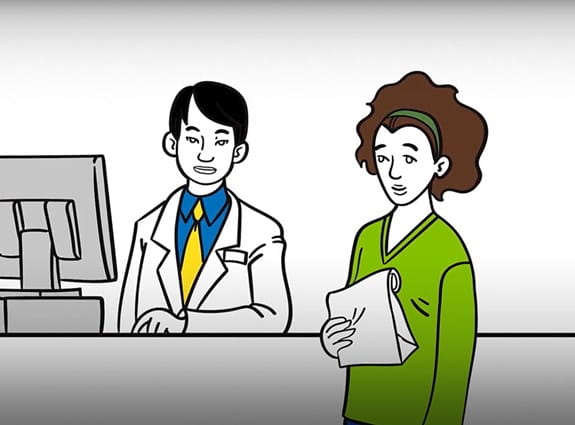Taking oral chemotherapy at home
[The main character appears on screen. She is a young woman with cancer. She has a bag of oral chemotherapy drugs from the pharmacy and she is reading the printed information that comes with it. Pill bottles, tablet packets and capsules appear on the table in front of her, representing the different types of oral chemotherapy drugs.]
Narrator: Your cancer treatment may include taking oral chemotherapy at home. You might call it oral chemo. These are drugs you swallow to treat cancer. They may be tablets or capsules.
[The scene changes and the narrator, a pharmacist, stands at the pharmacy counter and talks to the camera. The main character appears, holding her prescription. Then the pharmacist and the woman with cancer fade out and are replaced by 3 types of pills beneath 3 clocks with different times. This represents taking the right dose of the right drug at the right time.]
Narrator: As a pharmacist, I’m here to help make sure you take them safely and effectively. To make your treatment work as well as it possibly can, it’s important to follow the instructions you are given. You need to take the right dose of the right drug at the right time.
[The pharmacist is talking to the camera. As he emphasizes the items in each bullet point, different images appear next to him. Two tablets represent the dose. A clock represents when to take each dose. Then 3 different types of drugs appear to represent the order they are taken in. The drugs in the middle then disappear to represent missing a dose.]
Narrator: Make sure you understand :
- how much your dose is
- when you should take each dose
- if you take more than one drug, the order you should take them in
- what to do if you miss a dose
[The pharmacist introduces a series of images on the importance of storing and handling drugs safely. First, the main character stores her medicine in a high cupboard. Next, whole tablets and capsules appear on the screen with a spoon and some crushed pills beside them. A red circle with a line through it appears over the crushed pills. Next, the main character washes her hands. And finally, she throws drugs in the garbage – but a red circle with a line through it appears over the scene to reinforce the importance of returning unused drugs to the pharmacy.]
Narrator: It’s also important for you to store and handle your drugs safely. :
- Keep them out of reach of children and away from light, heat and moisture.
- Swallow tablets or capsules whole.
- Don’t cut, chew or crush them.
- Wash your hands immediately after handling.
- Return any drugs that don’t get used to your pharmacy so they can be destroyed safely.
[The scene returns to the pharmacist at the pharmacy counter. The woman with cancer appears at the counter, holding a pill bottle and looking worried. Then her notepad appears next to a pill bottle and some capsules.]
Narrator: You might be worried about side effects when taking oral chemotherapy at home. Talk to your pharmacist or someone else on your healthcare team about what to expect.
[The scene focuses on the person with cancer writing on her notepad, describing how she feels after taking her drugs. With her notes and pills in front of her, she calls her pharmacist or healthcare team to ask questions.]
Narrator: It can be helpful to take notes about how you feel after you take your drugs. Find out who to call if you’re concerned about anything.
[The Canadian Cancer Society’s name, logo, phone number and website address appear at the top of the screen. The Bank of Montreal (BMO) logo appears below as a proud sponsor of the Cancer Basics video series.]
Narrator: The Canadian Cancer Society is here to help. Visit cancer.ca or call us at 1-888-939-3333.

